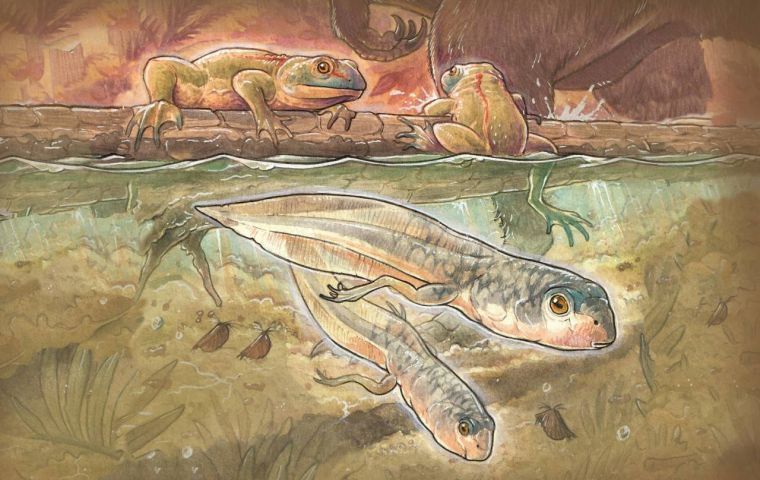MercoPress. South Atlantic News Agency
Oldest tadpole in the world discovered in Argentine Patagonia
 The researchers were looking for dinosaurs when the discovery was made by chance
The researchers were looking for dinosaurs when the discovery was made by chance Argentine researchers found by chance what resulted to be the oldest tadpole fossil in the world. According to an article published this week, the fossil was found in the province of Santa Cruz and is believed to have lived in the Middle Jurassic period between 161 and 168 million years ago. This unique specimen is said to shed light on the evolution of frogs and toads. It was found in January 2020, while searching for dinosaur remains.
This discovery “reveals fundamental aspects about the evolution of the life cycle of anurans, a group that includes frogs, toads, and squids,” said Mariana Chuliver, a researcher at the Félix de Azara Natural History Foundation (Universidad Maimónides, Argentina) and lead author of the study published Wednesday in the journal Nature.
“Notably, both N. degiustoi tadpole and adult reached a large size, demonstrating that tadpole gigantism occurred among stem-anurans,” the article noted.
The fossil, about 16 centimeters long, was found on a stone in an excellent state of preservation, which allowed the researchers to conclude that the morphology of the tadpoles has remained almost unchanged over the last 160 million years.
The animal belongs to a species known as 'Notobatrachus degiustoi', an ancestor of the modern anurans, a group of highly diverse tailless amphibians of which about 4,200 living species are known worldwide.
The appearance of the fossilized tadpole was by chance. A group of scientists from Argentina and China were in the area looking for dinosaur remains, especially Jurassic birds that are usually found in China and Germany but are rarely seen in Patagonia.
Argentine paleontologist Matías Motta recounted the moment: “We took a break after lunch one day and walked along a dry river,” he recalled. “We sat down and I picked up a rock that was next to me. I turned it over and that's when I noticed a series of small articulated vertebrae and a black outline forming a kind of tail. I showed it to my companions and we realized that it was a fossilized tadpole that included bones, the animal's eyes and tail,” he added.




Top Comments
Disclaimer & comment rulesCommenting for this story is now closed.
If you have a Facebook account, become a fan and comment on our Facebook Page!